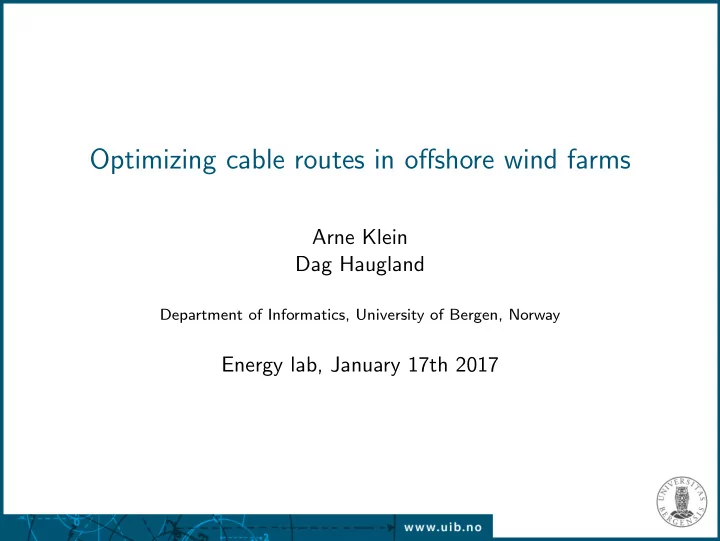

Optimizing cable routes in offshore wind farms Arne Klein Dag Haugland Department of Informatics, University of Bergen, Norway Energy lab, January 17th 2017
Offshore wind farm cabling Motivation ◮ High cabling and trenching costs offshore ◮ Often selected manually ◮ “Free” improvements by applying optimization ◮ Some companies (e.g. Statkraft) started using optimization methods ◮ Creating more advanced models, taking into consideration more aspects
Given data ◮ Wind turbine positions ◮ Substation position(s) ◮ Max. energy output of turbines ◮ Obstacles ◮ (Available cable types) ◮ (Cable paths for comparison)
Wind farm data ◮ Turbine and substation position data of offshore wind farms ◮ Barrow ◮ Sheringham Shoal ◮ Walney 1 ◮ Walney 2 Sheringham Shoal Walney 2
Problem properties Basics ◮ Cable capacity ◮ Connectivity ◮ turbines to substations ◮ Non-crossing Possible additions ◮ Branching ◮ Different cable types ◮ Obstacles ◮ Parallel cables ◮ Energy losses
Problem properties Basics ◮ Cable capacity ◮ Connectivity ◮ turbines to substations We want to ◮ Non-crossing ◮ Find optimal cable paths Possible additions ◮ Minimize total cable ◮ Branching length/cost ◮ Different cable types ◮ Satisfy constraints ◮ Obstacles ◮ Parallel cables ◮ Energy losses
Optimization method and solution method ◮ Mathematical model describing the problem ◮ Integer linear programming (ILP) ◮ Linear constraints ◮ Binary decision variable ◮ y ij = 1 means that there is a cable between turbine j and i ◮ Implemented using Python, solved by IBM CPLEX optimization library ◮ Non-crossing constraints ( O ( | N | 4 )) only added if solution violates them
Experimental results - one cable type ◮ Relative improvement from branching below 1% for all test cases ◮ Example Sheringham Shoal with C = 5 ◮ relative improvement 0 . 72% No branching Branching
Experimental results - two cable type (1) ◮ Cable capacity C > Q , cable cost c ij = 1 . 7 q ij Walney 1 14 C = 5 12 rel. difference [%] C = 6 10 C = 7 8 6 4 2 0 2 3 4 5 6 Walney 2 9 8 C = 5 rel. difference [%] 7 C = 6 6 C = 7 5 4 3 2 1 0 2 3 4 5 6 Q
Experimental results - two cable type (2) ◮ Walney 1, C = 7, Q = 2 No branching Branching
Parallel cables 5 5 5 4 4 4 3 3 3 2 2 2 1 1 1 0 0 0 3 2 1 0 1 2 3 3 2 1 0 1 2 3 3 2 1 0 1 2 3 ◮ Can improve solutions in some special cases ◮ Same mechanism in model allows to handle obstacles better
Parallel cables example, Walney 1 7000 +5.985e6 6000 5000 4000 3000 2000 1000 0 463000 464000 465000 466000 467000 468000 469000 470000 471000
Challenges ◮ Does not scale well with number of nodes ◮ High computational costs ◮ Information on cable cost hard to obtain
Thank you!
Recommend
More recommend